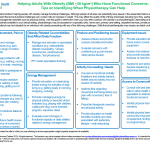Feeling like your wellness business’s website and email newsletter aren’t doing what they’re supposed to? Not really in the mood for a “big think” about fixing it? Wrap your head around these simple, time-tested ideas to dust up your site for better performance. Let’s go!
1. Make your home page about your customer, not you.
Why? New website visitors have one overriding question that successful home pages answer: “Is this for me?” They want to know whether you “get” their concerns and goals.
70% of your home page should reflect your potential customer’s perspective. Only 30% should be about your business.
Appropriate content for the home page:
YES: their fears, worries, hopes, aspirations, concerns, experiences, goals, interests, your general approach
NO: your personal mission, laundry list of your products and services, your corporate history, how marvelous you and your staff are
One national gym chain simply lists gym features on their home page – group exercise classes and basketball courts, for example.
Nothing answers the “Is this for me?” question. Site visitors get no insight into who they serve best. Is it athletic, competitive people? What about overweight folks who want to be more healthy? Potential members with chronic health concerns? Will women or people in their 40s feel comfortable? How about bodybuilders?
On the other hand, one yoga studio’s home page explains why their customers choose them. They help students “move with joy and ease” and offer an alternative to people who enjoy activity and movement but don’t want traditional fitness, yoga and dance. It’s easy to find hours, schedules, rates, and other details – but they understand that this isn’t the information that new site visitors need to see first.
2. Tell customer stories on your website.
Why? Potential customers want proof that you can help them. The most compelling evidence comes from your current customers.
Potential clients quickly connect when you share real customer stories on your website.
Sure, case studies and testimonials are the most popular examples of customer stories.
However, you’ll get more bang for the buck if you think outside the box. Interview them about what brought them to your business and what they considered when they decided to become a customer. Share your customers’ take on what works and what doesn’t. What surprised them about their experiences with your business? What advice do they have for potential customers?
Include plenty of real customer pictures (not stock graphics). Write captions that tell a mini-story explaining why the picture’s important.
For example, don’t just say “Leslie N., a Dallas member, works with Sarah, a certified personal trainer.” Instead, caption the picture “Leslie N., a Dallas member, is working with Sarah on successfully completing next month’s White Rock half-marathon.” That caption conveys that your club is a good fit for people with goals – even if they’re not trying to be a top-3 finisher!
3. Capture visitors’ email addresses.
Why? Capturing an email address for every visitor lets you control the flow of communication.
Without it, you have no way to reach out to people who have expressed an interest in your business. With it, you can use email marketing techniques to stay top of mind, reinforce the credibility of your business, and promote your products and services.
The easiest way to capture email addresses is to offer a monthly email that will interest the kinds of people who visit your site and eventually become customers or members.
Include an email sign-up box in the same position on every page of your website. The best position is near the top of the page and on either the far left or far right site of the page. Do not bury it at the bottom of the page or in the middle of the page where other content makes it hard to spot.
Offer something appealing in exchange for their initial signup. For example, one wellness center offers a free one-recipe makeover to each new email subscriber. It’s a fun freebie, gives the new subscriber some positive real-life interaction with the business, and helps promote their nutrition counseling services.
4. Add new and interactive content every month.
Why? Web marketing depends on multiple exposures to work.
Visitors won’t return to websites that never change. And engaging visitors in multiple ways builds a stronger impression than simply shoving articles at them.
While audio and video snippets can be very effective, interactive content doesn’t need to be high-tech or gee-whiz.
For example, a printable checklist or self-assessment is extremely interactive and encourages your site visitor to actually stop and spend time thinking about the core focus of your business.
5. Email your subscribers monthly.
Why? Your visitors will forget about you as soon as they leave the website. Use email to stay top of mind and refresh their interest.
A lengthy newsletter is not necessary or even desirable. Instead, provide short and sweet content – not just advertising – that sets your wellness business apart. Avoid the canned wellness tips available at the checkout stand and all over the internet.
Be creative! For example, you could offer a freebie, share a customer success, provide some tips with local flavor, answer one or two reader questions, invite subscribers to an event that your club jointly promotes with another wellness business.



